Asphodelaceae
Aloe kamnelii Van Jaarsv.
Family:
Common names: Doorn River aloe (Eng.); Doringrivier-aalwyn (Afr.)
Plant Attributes:
Plant Type:
SA Distribution:
Soil type:
Flowering season:
PH:
Flower colour:
Aspect:
Gardening skill:
Special Features:
Horticultural zones

Aloe lineata (Aiton) Haw. var. muirii (Marloth) Reynolds
Family:
Common names: Muir's striped aloe (Eng.); streepaalwyn (Afr.)
Plant Attributes:
Plant Type:
SA Distribution:
Soil type:
Flowering season:
PH:
Flower colour:
Aspect:
Gardening skill:
Special Features:
Horticultural zones

Kniphofia acraea Codd
Family:
Common names: highlands poker
Plant Attributes:
Plant Type:
SA Distribution:
Soil type:
Flowering season:
PH:
Flower colour:
Aspect:
Gardening skill:
Special Features:
Horticultural zones

Gasteria koenii Van Jaarsv.
Family:
Common names: Osberg ox-tongue (Eng.); osberg-beestong (Afr.)
Plant Attributes:
Plant Type:
SA Distribution:
Soil type:
Flowering season:
PH:
Flower colour:
Aspect:
Gardening skill:
Special Features:
Horticultural zones

Aloe reitzii Reynolds var. vernalis D.S.Hardy
Family:
Common names: Vryheid aloe
Plant Attributes:
Plant Type:
SA Distribution:
Soil type:
Flowering season:
PH:
Flower colour:
Aspect:
Gardening skill:
Special Features:
Horticultural zones

Aloe howmanii Reynolds
Family:
Common names: Howman’s cliff aloe (Eng.); waaier-grasaalwyn (Afr.)
Plant Attributes:
Plant Type:
SA Distribution:
Soil type:
Flowering season:
PH:
Flower colour:
Aspect:
Gardening skill:
Special Features:
Horticultural zones

Aloiampelos Klopper & Gideon F.Sm.
Family:
Common names: climbing aloes, rambling aloes, scrambling aloes (Eng.); rankaalwyne (Afr.)
Species
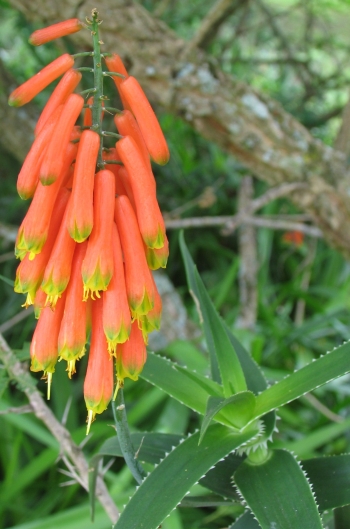
Aloiampelos ciliaris (Haw.) Klopper & Gideon F.Sm. var. ciliaris (= Aloe ciliaris var. ciliaris)
This tangled, climbing shrub has sheathing leaf bases that are collar-like, ciliate (with a fringe of hairs) and auriculate (ear-lobe-shaped). The green leaves are spreading to recurved. Racemes are short, broadly cylindrical and densely flowered. The bright red, cylindrical to slightly curved flowers are ± 30 mm long with pedicels (flower stalks) that can reach a length of 5–8 mm and are present throughout the year. This plant climbs through bushes, shrubs, and trees in bushland, wooded ravines and thickets of the coastal belt, and is always found near the sea in frost free areas. It only occurs in a narrow coastal strip from near Humansdorp to north of the Kei River Mouth, Eastern Cape, South Africa.
Aloiampelos ciliaris var. redacta (S.Carter) Klopper & Gideon F.Sm. (= Aloe ciliaris var. redacta)
The characters of A. ciliaris var. redacta are intermediate between those of the other 2 varieties of the species. However, it is not considered to be of hybrid origin. This climbing aloe flowers from November to April, and is considered to be Vulnerable (VU). It grows on sand dunes at the forest edge in a small area along the Kei River and around Qolora Mouth, Eastern Cape, South Africa.
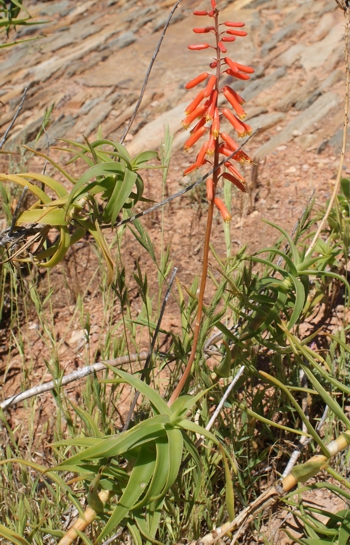
Aloiampelos ciliaris var. tidmarshii (Schonland) Klopper & Gideon F.Sm. (= Aloe ciliaris var. tidmarshii)
A tangled, climbing shrub, where the sheathing portion of the leaf base is only very slightly auriculate (ear-lobe-shaped) and the margin very minutely ciliate (with a fringe of hairs). This variety of A. ciliaris is in all aspects smaller than the typical variety of the species. Racemes are sublaxly flowered and more narrowly cylindrical than those of var. ciliata. The red flowers (16–23 mm long) and pedicels (flower stalks) (4–6 mm long), are also shorter, and present from November to April. This variety grows on stony, clayey soils in relatively dense savanna woodland, at higher altitudes and further from the sea than A. ciliaris var. ciliaris. It is restricted to an inland strip of the Eastern Cape along the Zuurberg range, South Africa, and is endemic to the Albany Centre of Endemism.
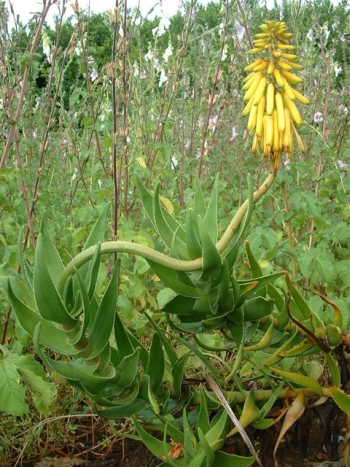
Aloiampelos commixta (A.Berger) Klopper & Gideon F.Sm. (= Aloe commixta)
The dull green leaves, with striatulate sheaths, of this branched, sprawling shrub are borne erectly (usually pointed towards the growing tip), not recurved. The peduncle (inflorescence stalk) is stout (15–17 mm in diameter) and bears a short, almost capitate (head-shaped), rather densely flowered, bicoloured raceme. Flowers are orangey-red in bud, but mature flowers are cylindrical, orange-yellow and 40 mm long, with pedicels (flower stalks) of 3–4 mm long. Plants flower from August to September. This creeping aloe is considered to be Vulnerable (VU) and is restricted to sandstone of the Table Mountain Group, where it grows between rocks and low shrubs in acidic soils, in an area of high winter rainfall, and close to the base of the summer mist belt. It is confined to the Cape Peninsula, Western Cape, South Africa.
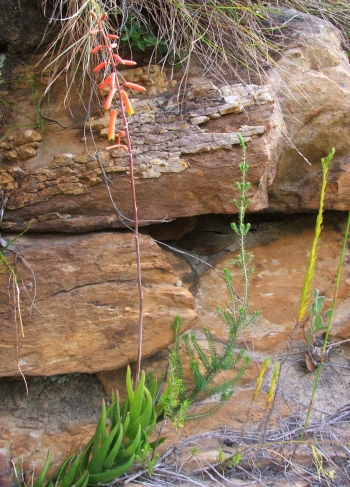
Aloiampelos decumbens (Reynolds) Klopper & Gideon F.Sm. (= Aloe decumbens)
This much-branched shrub has slender stems that are decumbent, but with the foliate portion held erect. The spreading leaves are bright green and faintly striate. The peduncle (inflorescence stalk) is slender (4–5 mm in diameter) bearing a sublaxly flowered cylindrical raceme. The red flowers are 28–33 mm long, cylindrical and slightly curved, with pedicels (flower stalks) of 4–5 mm long. Plants flower throughout the year, but flowering time is mostly between November and January. This species is considered to be Vulnerable (VU) and grows in South Langeberg Sandstone Fynbos on cliffs and steep north- and south-facing slopes, on sandstone of the Table Mountain Group. It is only known from the Langeberg (Riversdale region), Western Cape, South Africa.

Aloiampelos gracilis (Haw.) Klopper & Gideon F.Sm. (= Aloe gracilis)
The only faintly striated leaf sheaths of this much-branched shrub are not auriculate (ear-lobe-shaped) and lack ciliate margins. The dull green leaves are erectly spreading. Red flowers of 40–45 mm long, with pedicels ± 8 mm long, are borne in a laxly flowered, slightly conical (cone-shaped) raceme from May to August. This species grows in the ecotone between forest and fynbos at the eastern limit of the area that receives all season-rainfall. It typically occurs on stony places in thickets, along rocky hillsides and on steep rocky slopes of the coastal plain, or up to the top of the first range of mountains. It is only found in the Port Elizabeth and Joubertina areas, Eastern Cape, South Africa and is, therefore, more or less restricted to the Albany Centre of Endemism.
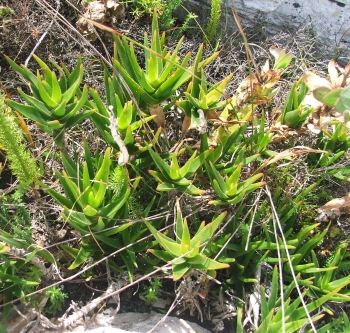
Aloiampelos juddii (Van Jaarsv.) Klopper & Gideon F.Sm. (= Aloe juddii)
This branched shrub has erect to somewhat creeping, densely foliate branches of ascending (upward curving), green leaves. The peduncle (inflorescence stalk) is robust (8–9 mm diameter) and bears sublaxly flowered, cylindrical racemes. Flowers are orange-red, 40 mm long, cylindrical and slightly curved, with 10–12 mm long pedicels (flower stalks). Plants flower in November. This Endangered (EN) species grows on southeast-facing rocky slopes on sandstone of the Table Mountain Group, in Overberg Sandstone Fynbos vegetation. It is thus far only known from the Baardskeerdersbos region east of Gansbaai (Overberg coastal mountains), Western Cape, South Africa.
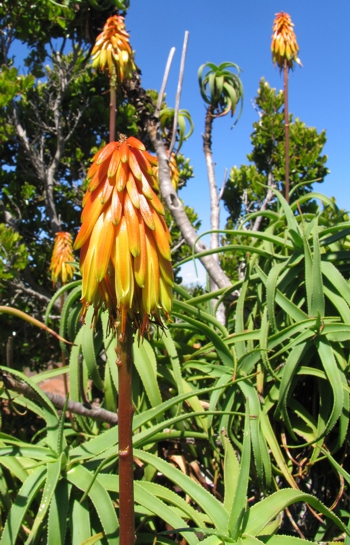
Aloiampelos striatula (Haw.) Klopper & Gideon F.Sm. var. caesia (Reynolds) Klopper & Gideon F.Sm. (= Aloe striatula var. caesia)
This aloe has a rambling growth form. Aloiampelos striatula var. caesia has more spreading, closely packed and more rosulate, shorter, greyish green leaves than A. striatula var. striatula. The leaf sheaths are also shorter and only obscurely lined. Racemes are narrow, cylindrical to cone-shaped, and relatively densely flowered. Flowers are short, straight, yellow, ± 30 mm long, and present from December to January. This rambling aloe grows among rocks on mountain tops within the winter snow belt. It only occurs in the west-central region of the Eastern Cape in the area between Queenstown, Cradock, and Middelburg, South Africa. It is restricted to the Albany Centre of Endemism.
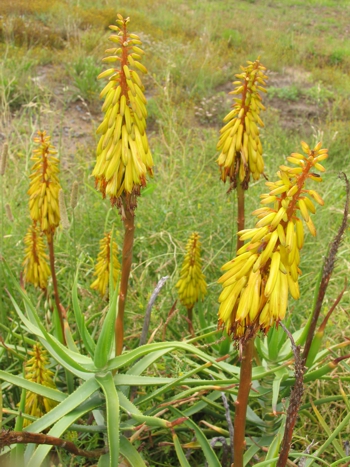
Aloiampelos striatula var. striatula (= Aloe straiatula var. striatula)
This rambling aloe is the most robust member of the genus Aloiampelos. The recurved, shiny, dark green leaves have leaf sheaths that are distinctly longitudinally green-lined. Racemes are cylindrical to cone-shaped and relatively densely flowered. Flowers are slightly curved, reddish orange, 40–45 mm long and clasp the peduncle (inflorescence stalk). Flowering occurs mostly between October and November. This aloe grows among rocks on mountain tops within the winter snow belt in one of the coldest parts of southern Africa. It is distributed in the higher areas of the eastern and northeastern parts of the Eastern Cape, South Africa, and in southern Lesotho, with a disjunct distribution in the southeastern Free State, South Africa and western Lesotho.
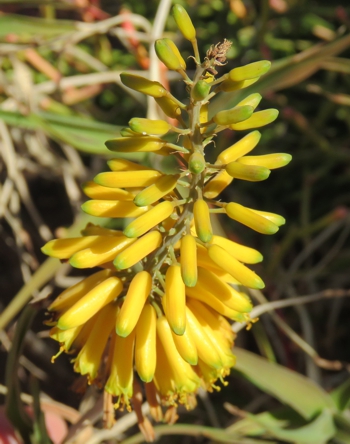
Aloiampelos tenuior (Haw.) Klopper & Gideon F.Sm. (= Aloe tenuior)
The fence aloe forms untidy shrubs, with a large subtuberous to woody rootstock. The erectly spreading leaves are blue-green and the leaf sheaths are not auriculate, but are obscurely lined, and often splits longitudinally. Elongated, rather densely flowered racemes with small, red, orange, or yellow cylindrical, straight flowers are mostly present from October to December. However, the flowering period is variable at different localities and appears to be dependent on rain. Aloiampelos tenuior is a very variable taxon and some of its extreme variants have been described as varieties, but these are generally not upheld. It grows in open country on sandy soil, rarely in valley bushveld, but sometimes on steep slopes. It occurs from the Port Elizabeth and Jansenville areas in the Eastern Cape into southern KwaZulu-Natal, with a disjunct distribution in northern KwaZulu-Natal at the Swaziland and Mpumalanga border, South Africa.
Plant Attributes:
Plant Type:
SA Distribution:
Soil type:
Flowering season:
PH:
Flower colour:
Aspect:
Gardening skill:
Special Features:
Horticultural zones

Aloe varimaculata McCoy
Family:
Common names: Humpata aloe (Eng.); Humpata-aalwyn (Afr.)
Plant Attributes:
Plant Type:
SA Distribution:
Soil type:
Flowering season:
PH:
Flower colour:
Aspect:
Gardening skill:
Special Features:
Horticultural zones

Aloe rouxii Van Jaarsv.
Family:
Common names: Low's Creek grass aloe (Eng.); grasaalwyn (Afr.)
Plant Attributes:
Plant Type:
SA Distribution:
Soil type:
Flowering season:
PH:
Flower colour:
Aspect:
Gardening skill:
Special Features:
Horticultural zones

Aloe reynoldsii Letty
Family:
Common names: yellow spineless aloe, Mbashe aloe
Plant Attributes:
Plant Type:
SA Distribution:
Soil type:
Flowering season:
PH:
Flower colour:
Aspect:
Gardening skill:
Special Features:
Horticultural zones






Rate this article
Article well written and informative
Rate this plant
Is this an interesting plant?
Login to add your Comment
Back to topNot registered yet? Click here to register.